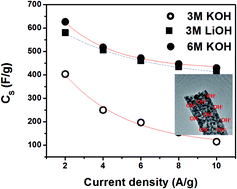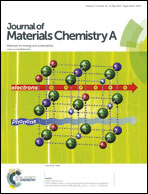Superior supercapacitive performance in electrospun copper oxide nanowire electrodes†
Abstract
Copper oxide (CuO) nanowires of diameter ∼30–50 nm were developed by an aqueous polymeric solution based electrospinning process and their structural, morphological, and electrochemical properties were studied with the aim to fabricate high performance supercapacitor devices. The wires consist of densely packed cuboidal particles of size ∼10 nm characterized by a low degree of crystal defects. Supercapacitor electrodes were fabricated on nickel foam substrates using 75 wt% CuO in 15 wt% conducting carbon and 10 wt% polyvinylidene fluoride. The supercapacitive properties of the electrodes were evaluated in a three-electrode configuration in aqueous electrolytes, viz. KOH and LiOH, employing cyclic voltammetry (CV), charge–discharge cycling (CDC) and electrochemical impedance spectroscopy (EIS). A record specific capacitance (CS) is observed for the present electrospun CuO nanowires: CS ∼ 620 F g−1 in KOH and 581 F g−1 in LiOH at a current density of 2 A g−1 with a Coulombic efficiency of ∼100%. Compared with the previous results on the electrochemical stability of CuO nanostructures, the material electrospun using an aqueous polymeric solution showed a much higher operational stability (98% at the end of 1000 cycles and 92% at the end of 2000 cycles) owing to its superior crystallinity. The electrochemical properties of the electrodes were determined using EIS to validate the CV and CDC results.


 Please wait while we load your content...
Please wait while we load your content...